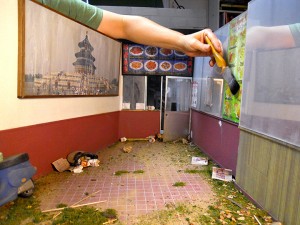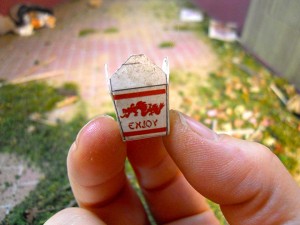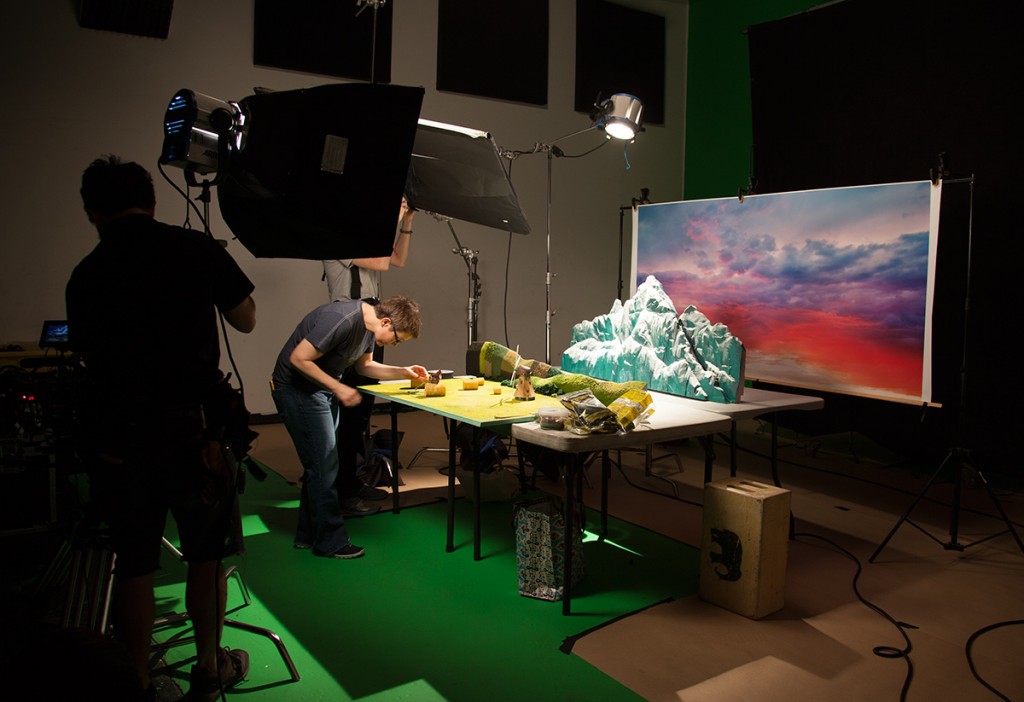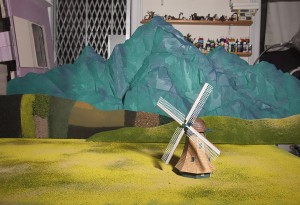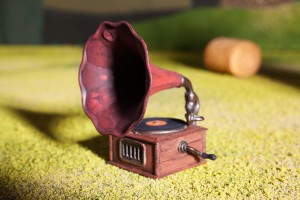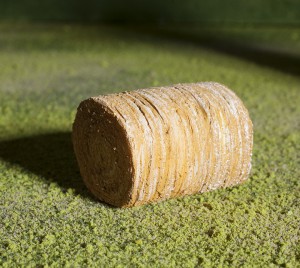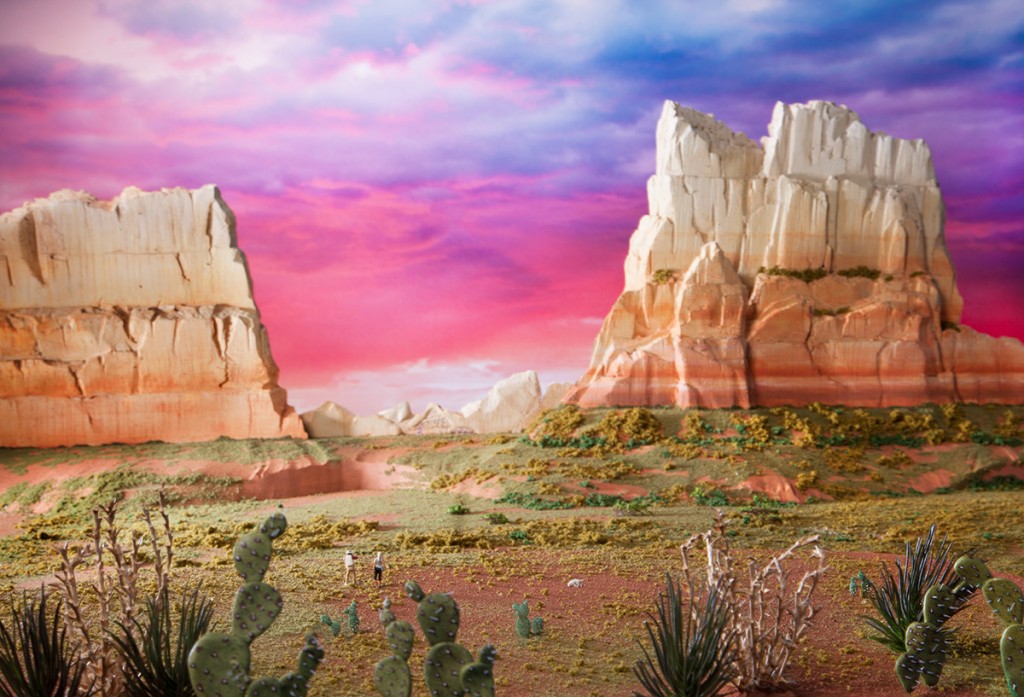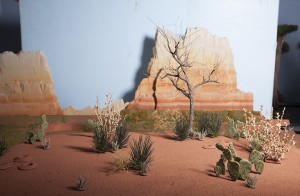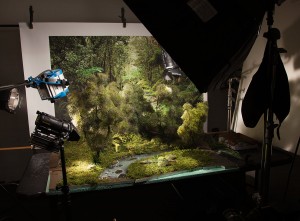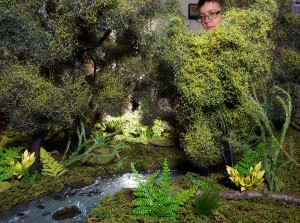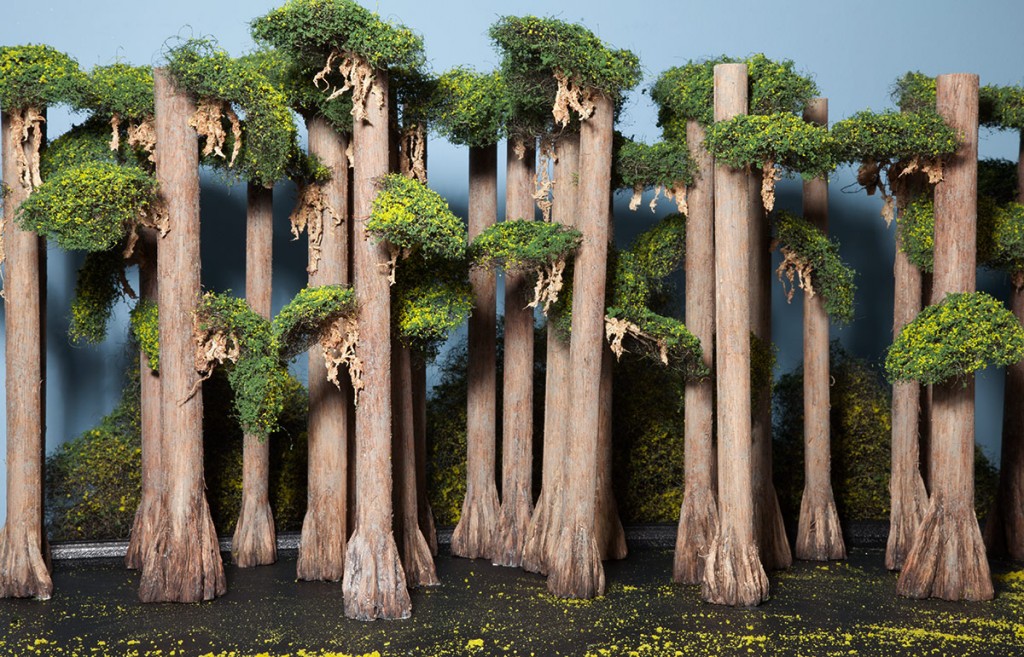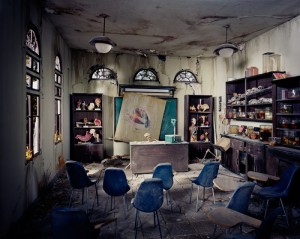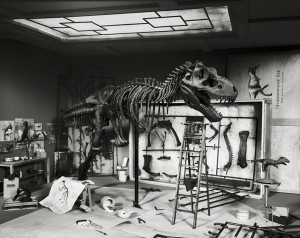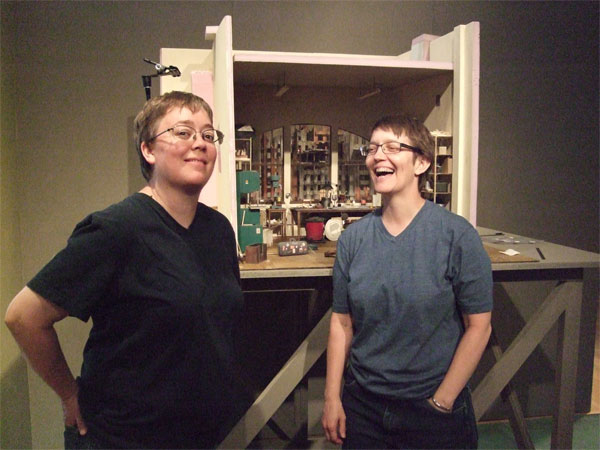As part of Lori’s “Power of Nature” exhibition at Museum Schloss Moyland, we took part in an interview with one of the museum’s curators, Dr. Alexander Grönert. Part one of the interview is available for viewing online at the link above. Enjoy!
Fall has been a blur in the studio this year all thanks to a delightful little cookie. We were hired to create our very first stop motion animation set to be used in a Halloween campaign by Oreo. The project was to shoot five vine videos that would be released, one a day, the week of Halloween on the various social media used by Oreo-- Facebook, Twitter, Instagram. The basic premise was that in the Oreo Laboratorium, Oreo cookies were being combined with other candies to create new creatures called Nomsters. The videos would show the origins of each Nomster.
The ad agency, 360i, contacted us about designing and building a miniature mad scientist laboratory where all the action was to happen. In addition to the large set (approx 64"long x 24"deep x 30"high), we provided the miniature props that outfitted the set and interacted with the Nomsters. It was a tight building schedule, we had about a week and a half to create everything, but in the end that may have been a blessing in that we had to really streamline the designs.
As it usually happens, Lori concentrated on the bones of the set, established the scale, color palette, and got to work building furniture and laboratory-esque machines that would really give the set a spooky feel. I focused on the smaller pieces that would populate the shelves, cover the tables, and essentially fill in the corners of the space. It became all consuming and it took us up to the absolute last minute to complete everything. We have learned from making other sets that flexibility and offering many options is the way to go. As we have learned, and has proven true for each job like this we have worked on, inspiration and improvisation on set are inevitable so we have to do our best to be ready to assist.
This job was unique (at least to us) in that the finished videos were going to be used across various social media platforms. So when the director and animator were planning the shots they had to take absolutely everything into account. It was incredible to witness their process as they discussed lenses, aspect ratios, camera angles, and lighting concerns. It is so different than the "fine art" work that Lori and I do, which in many respects seems quite simple compared to juggling all of these moving parts.
It was a long, intense week of filming but with great results. In the end, everyone was quite pleased with the completed videos. We hope you like them too!
We finally got word on the airing of the How It's Made episode featuring myself and Lori working in the studio. I’m excited to say that the segment on Dioramas will finally be airing on the Science Channel (in the US) on Monday, September 29th 2014 at 10pm (Eastern Time Zone). Check it out!! Please note that this is the info that was passed on to us by Discovery, it’s parent company. Please check their website and your local listings to double check the time closer to the air date in case there are any changes.
http://science.discovery.com/tv-shows/how-its-made/tv-schedule.htm
A few months ago we were approached by our good friends, and amazing talents, Josh Ruben and Vincent Peone. They had a project coming up and were requiring small sets for use in a series of web videos. The client was Greenpeace and they were going to combine our sets and an actor via green screen, Mr. Reggie Watts, improvising the words/message. Of course we said YES! The sets they wanted were to illustrate some very different environments –an alpine mountaintop, a jungle, a desert, and kind of a swampy bayou. It was great. All super different with vastly different styles of plants and terrain. They needed certain elements for each scene to fit their overall approach: stream for the jungle, floating lilypads for bayou, open meadow with windmill for alpine setting, and big open area with prairie dog holes for desert. Apart from those, and a few other must-haves, we were able to design the sets as we saw fit. (That is the beauty of a long-term work relationship. They trust us to be creative and we make sure they have plenty of options for creative flexibility with the sets.) We had about a month to complete the models. We made them so they could be disassembled and transported to the shooting studio.
Shooting days are always really long and tiring for us. I’m sure for those that do it all the time they become accustomed to the schedule and the pace, but for Lori and me it is exhausting. The plan was to shoot the sets in the morning and in the afternoon they would do the green screen work with Reggie. They had numerous tech guys on set working their magic so the video footage would be ready for the afternoon. It was intense! A huge production crew, plus people from the advertising company, plus a small delegation from Greenpeace, made for a full house. Here is the breakdown of how it went shooting each set.
Alpine Mountain-Three main elements consisting of background mountains, a long line of rolling hills, a grassy plain for everything to sit on. Round hay bales of varying size (to force the perspective) dotted the landscape. Had to flatten one so a small gramophone could fit on top and without thinking I took off a big slice – I had no hay colored paint to touch up. Oops! Flipped it over and had to make due with the unfinished (but painted) underside. The windmill, special ordered from Germany, did not turn as needed. Not realizing it was wired differently, we blew the motor even before we started. Luckily, resourceful guys from their art department came up with a solution and saved the day.
Desert- Two main elements – “expansive” open desert with flats of mountains in the distance and a smaller section of desert, elevated and close to the camera, where they could have Reggie do his thing. The spotlight they were using to simulate the sun peeking over the mountains started melting the set. Tried to block out the melted areas with gaffer's tape and Cinefoil. We also couldn't get our tumbleweed to adequately tumble across the set. It kept getting caught in trees and things. I think they fixed it digitally.
Jungle- This had one main element with removeable trees for easier transport. Pretty smooth shoot on this one. Got to use the fog machine too!
Bayou- One big dog pan of water, a box of individual trees, and a handful of paper lilypads. The lilypads proved to be the tricky part here. Lori and I had to pull one across the width of the pan at an even pace. Our fishing line proved to be too wimpy and we had to redo it on set with line from the art department. Also, we lightly stirred the water to make it look more real, causing all our of smaller lilypads to consistently flow to the front of the pan. I got to/had to stand right by the fog machine. It was not vanilla scented like our machine at home.
All in all, another great experience in our little world of set building. It is something we enjoy and hope to continue to explore. Check out the completed videos at Greenpeace Videos
We are very excited to share that two of Lori's photographs are in an exhibition at Flowers Gallery in New York through August 30th! The photos on display are Anatomy Classroom and Laundromat. It is a really beautiful show with a wide range of images all spun around the theme of the Interior. At the moment I'm mesmerized by one of Jason Larkin's pieces, which features small scale, table top sized breeds of cattle. His photo is beautiful, but the cattle models themselves really knock me out! Find out more about the show at http://www.flowersgallery.com/media/226318/press_release_-_interiors_new_york.pdf. It's well worth the trip to Chelsea!
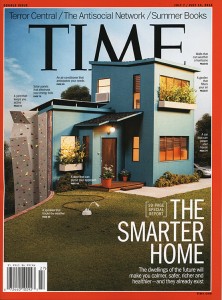 Life is pretty crazy right now. Part of what makes it so crazy is that we just made an image for the cover of Time magazine!! The fact that it is an iconic reference that most people understand is beyond belief. A niche trade publication with low readership is much more our speed -- "Post Modern Saw Blades" or something like that (if that is a real magazine, you have my apologies!) The fact that my mom can get it at her grocery store blows my mind.
Life is pretty crazy right now. Part of what makes it so crazy is that we just made an image for the cover of Time magazine!! The fact that it is an iconic reference that most people understand is beyond belief. A niche trade publication with low readership is much more our speed -- "Post Modern Saw Blades" or something like that (if that is a real magazine, you have my apologies!) The fact that my mom can get it at her grocery store blows my mind.
So anyway, it's "The Smarter Home" issue - July 7 / July 14 . Here's a video that the people of Time made to coincide with the release of the magazine. Hope you like it!
http://lightbox.time.com/2014/06/26/smart-home-time-lori-nix
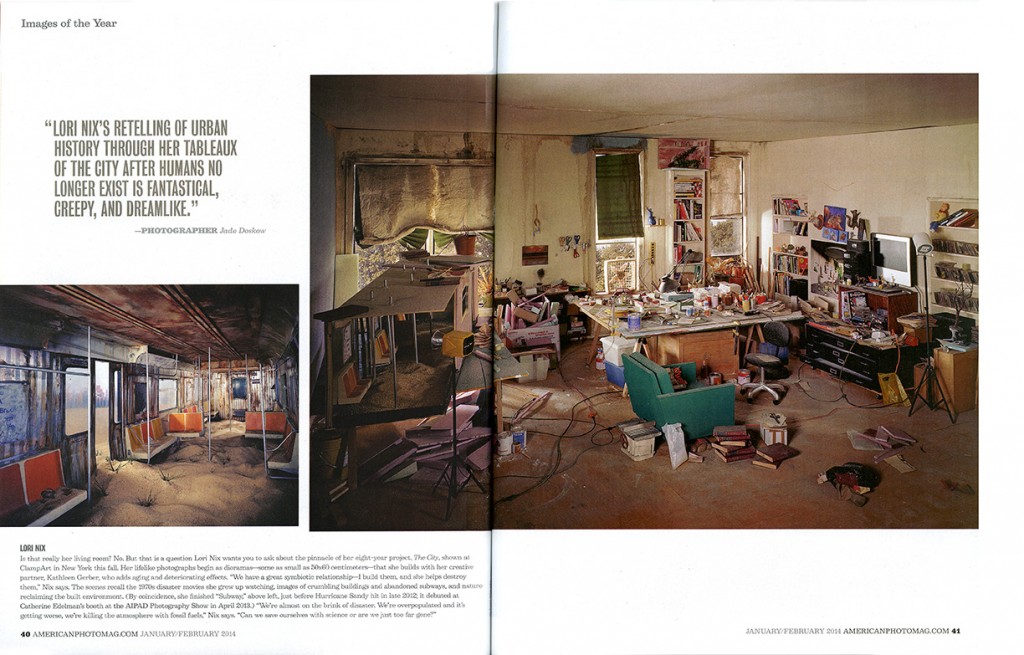 Before we get too far into 2014 I want to give a shout out to Lori for having two of her images included in American Photo’s “33 Best Images of the Year” for 2013. Lori’s Subway and Living Room made the cut along with images by Edward Burtynsky, Bryan Schutmaat, Jen Davis and others in this year’s selection.
Before we get too far into 2014 I want to give a shout out to Lori for having two of her images included in American Photo’s “33 Best Images of the Year” for 2013. Lori’s Subway and Living Room made the cut along with images by Edward Burtynsky, Bryan Schutmaat, Jen Davis and others in this year’s selection.
The full selection can be seen in the January/February 2014 issue as well as online at http://www.americanphotomag.com/photo-gallery/2013/12/images-year-2013-1
The interview with Lori is finally out! Here is the link to Mark's awesome blog. Thanks Mark! http://saint-lucy.com/conversations/lori-nix/
See the video now. http://vimeo.com/36994466
This past fall we were invited to be a part of an exciting and memorable project. Our new good friend, Joe Sabia, was putting together a team to create a video about sustainable sushi. Inspired by a conversation with chef Kristof0r Lofgren of Bamboo Sushi in Portland, Oregon(theU.S.’s first certified sustainable sushi restaurant), he wanted to help Kristofer’s efforts to spread the message about the need for better commercial fishing practices. Joe has a background in television and video, and is a passionate and skillful storyteller. His talents seemed like the perfect fit for Kristofer’s message.
From the beginning Joe imagined this “story of sushi” to be told using models, and luckily for us, word of mouth and some internet searching led him to Lori’s website. He liked the possibility of using the models to create another world and appreciated the detailed nature of Lori’s photographs. The whole idea of making miniature sets for somebody else to work with was intriguing as well as scary. We had never worked with other artists like this, but it is a great cause and also seemed like the end result could be something pretty special. The project would definitely push us out of our comfort zone and interrupt our usual studio production, but it would also be a good opportunity to move our skills to the next level, both in terms of what we could physically produce and also what we could offer a client commercially in the future. (Always afraid the “art” might dry up, we are perpetually trying to nurture our other options.)
Ideas were discussed and a general storyline was hammered out. We then drew out a storyboard (first time for everything) to further refine the narrative and provide a shot sequence. It was decided that Lori and I would build 5-7 sets, each illustrating a step along the sushi path – from the fishing boat all the way to the restaurant table. The specifics were left up to us. So, we retreated to our respective corners to get to work. Knowing that the ‘detail work’ would fall to me, I started reading up on the world of sushi fishing and commercial fish markets. Lori started making lists and sourcing materials to begin building the structures we would need. Thank God for the internet!
Now, the beauty of making dioramas for Lori’s photographs is that she knows exactly what viewpoint she wants to have from the outset. All the elements of the scene are then made with that viewpoint in mind. Backs of structures are often unpainted or unfinished because we know that the camera will never see it. But, building dioramas for someone else to film, not knowing what crazy angle they may want to shoot or what close-up they may take, was quite nerve wracking and made us (me) overbuild the scenes even more than usual. One of my biggest fears, was them wanting to film a particular shot and not being able to do so because what I had made was not detailed enough or somehow incomplete or incorrect. For example: I made numerous fish of various species, but I tried to make sure that they would be from the same part of the ocean (mostly- I got really tired near the end). That the type of fishing boat we depicted, and the method of catching fish, were in line with the type of fish and by-catch I sculpted. That the tables and storage containers were appropriate for the type of market. It got a little crazy at times with Lori saying “What does it matter if the blah blah blah blah?” and me answering “That’s not how it really would be, that doesn’t really yada yada yada” and then some strained silence for a while. But we managed…
And we kept working. We knew we had about four months to get these eight dioramas made. (Thankfully the deadline got extended!) Some were very direct and contained. Others were sprawling and involved a lot of smaller elements. We would email in-progress images to keep Joe in the loop. By now a director of photography/cameraman was also on board, Vincent Peone. He visited the studio with Joe and had a lot of great ideas for how to shoot the scenes. We met a couple times during production of the dioramas, and each meeting left us feeling even more excited about the project. This was Lori and my first big commercial job and we really wanted it to go well. Previous jobs were much more short term, a couple weeks at best. This job was proving to be a real test of our stamina, both mental and physical.
One amazing sidebar to all of this work was an excursion to Montauk to get a close look at commercial fishing. Through chef Kristofer, we were able to meet Michael Dimmock, who is head of an awesome company, Sea to Table. They work with fisherman to get their catch into the hands of chefs in the most direct way possible. Because of their efforts fishermen get a fair price, and chefs and restaurants get insanely fresh seafood (it usually arrives the next morning) to prepare for their customers. It’s a beautiful thing. Michael gave us the insiders tour where we got to see boats up close, watch fish being processed and packaged for quick shipping, and just witness a completely different way of life. It was fantastic!
Back in the studio, shooting day approached. By now the dioramas were taking over the majority of the available space, with elements stretching into four different rooms of the apartment. Joe and Vincent came for a final pre-shoot visit and we took them through each set. Most of the discussion was about transitions from scene to scene, lighting possibilities, special effects, and figures to populate the scenes. Figures, argh! We had been able to find scale model figures to work on the fishing boat(s) and in the market scenes. We had not prepared for populating the restaurant scenes. Lori and I make no secret that figures are not our strong suit. My attempts at sculpting them have been arguably passable. Knowing that we couldn’t make the little people, the only option was to find them. Thankfully, Lori is a tenacious shopper and she quickly located resin figures of the correct scale that we could make work. By ‘make work’ I mean saw off the legs of about half of them and modify to make them seated rather than standing, grind away unwanted elements, and repaint. But they did work, and they really made the scenes. We were as ready as we were gonna be.
We thought we were as ready as we could be. It was 9 am on a Saturday. Lori and I made finishing touches on the dioramas while the guys got set up. It is just a whole different world. And so much stuff! Fancy camera, lighting systems, dolly set up- we had just enough room, and no more. Hard traveling cases and extra gear filled the kitchen and bedroom. The back half of the living room/studio became the main shooting area. That area was dominated by the “ocean expanse” complete with boat shaped cut-out so we could switch out the two different fishing vessels –one using traditional fishing methods, the second using sustainable methods. All of the shots requiring this set were done first. It took all available personnel and some innovative problem solving to create many of the visual effects. Vincent truly transformed the sets with creative lighting and energizing camera shots.Working on this smaller scale was a new and long awaited experience, and his enthusiasm really shows.
Because setting up the equipment was so involved it was decided to keep the camera in place and move the sets for shooting. Once the boat was removed, the “ocean” became the perfect table to host the other scenes. The dock scenes were filmed next, followed by the two different restaurant scenes, and then the trawling net. Throughout all this, Joe kept a watchful eye on the script and worked out the time required for each shot with Vincent. Lori and I both felt like we didn’t want to watch the raw footage. We preferred to be surprised by the final edit.
By early evening we had exhausted our initial filming area and had to move all the camera equipment and lights to shoot the final models. This market area consisted of three separate models side by side representing different aspects of the commercial fish market experience, from very large, high volume market to a smaller, more intimate space at the end. We wanted each model to be distinct as the camera panned across the interiors. Style of architecture, color, and lighting were crucial in achieving the differences in the spaces. These three models had taken the most time to build due to the amount of detail. And so many fish! Yikes!
Creating movement within the scenes was as important as effects done with the camera. We took advantage of every opportunity, whether it was a rocking boat, drifting clouds, or rolling mist on the water (cue the fog machine). Some are more obvious (check out the hefty rod leading the fish through the trawling net), others a bit more subtle (well placed fishing line opening the hatch or a hand just out of frame pushing a forklift). It was about as low tech as you could get, but so much fun! But I think it was in the same spirit as the models themselves. A little bit wonky, but it still made sense.
We finally wrapped around 11 that night. It had been an incredibly long day and everyone was beat, but also very pleased with the raw footage. Lori and I were so glad our part of this project was complete. Now the others could work their magic. It would feel strange to go back to the artwork and leave the sushi project behind. It had dominated our studio lives (and regular lives) for such a long time. We couldn’t wait to see the final video!
It’s been a crazy week. I’ve had the great fortune to be included in a brand new show at the Museum of Art and Design here in New York. It’s called Otherworldly, and includes a wide range of artists who use models/dioramas in some capacity for their work. Some have the model as the final piece of art, others are like me and the model is a means to an end, either a photograph or painting. Others have taken it in totally different directions including a hologram and a zoetrope! For me it’s a big step to show the diorama along with the final photograph and I’m still not sure how I feel about it. (Generally, once I’m satisfied with the final image I dismantle the scene to make way for the next one.) So much of the final image is about lighting; it just doesn’t translate the same if you are looking at the original model. Often I have to pump the lights 15-20 times to get the right density. Just doesn’t happen in real life. Same thing when I have to use the fog machine to create atmosphere- just not the same! Before now, the only place you could see one of the dioramas was in my studio. But the fact that this was a museum show, and in a way an educational experience, made the difference for me.
All that being said, it’s pretty cool. Kathleen and I installed the work last Friday. Two sets, Beauty Shop and Violin Repair Shop, were chosen by the show’s curator David McFadden. It was lucky for me that they were manageable in size and recently completed. I don’t know how I could have stored them for any real length of time. Space in the studio is at a premium. Beauty Shop was completed earlier in the year and we had time to glue down all the different elements so installation was just a matter of pinning the ceiling in place. Violin Repair Shop was a different story. It’s the most recently finished piece so there was no time to give it the same attention. Plus, we try to reuse what we can and there’s a lot of nice, detailed pieces in that scene. The chair, tables, lights, shelves, and tools all have potential for future scenes. Gluing them down would negate that potential. Even if that stuff just ends up being background filler for another diorama it’s worth it. Trying to simulate years and years of accumulated ‘stuff’ can be very difficult. Having a stash to access helps.
In the end, Violin Shop got lodged in the doorway of the apartment as we were trying to take it to the car. We had to cut it down on one side to release it from the door jam. It took a couple of hours to install, and that’s even with us being somewhat organized. When originally packing it up, Kathleen labeled all the tiny boxes with their even tinier contents, just like if you were moving to a new house. I unpacked the boxes and she placed the items in the scene. We had to keep going around the corner to look at the photograph to get things placed correctly. Even then we realized we left crucial elements at home so we had to go back on Saturday to finish up. And by elements I mean freakin’ stand up basses that are right up front in the scene. Figures right?
One of the nicest parts to all this was talking with a security guard who was overseeing the installation. She said that she would be guarding my work for the duration of the show and that I should not worry about its’ safety. She was very interested in all of the artwork being installed, but told us that she especially liked Violin Shop. She even asked questions about it so that she could talk to visitors about the piece. We showed her some of the carved elements and she was happy to get a closer look. It was a really nice conversation.





